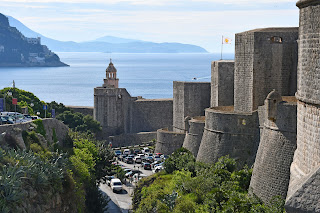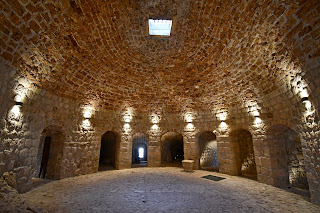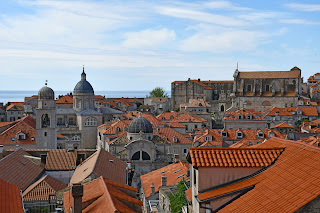Balkans Road Trip: Day 8 – Dubrovnik
When planning this journey, I wanted to include a buffer day in the middle in case we got waylaid. However, because Dubrovnik is by far the best-known city on Croatia’s coast, this day ended up getting moved to day 8. Fortunately, we met with no trouble on our route, so this day ended up being quite restful. I was also very thankful for it, as the skies ended up being sunny until early in the afternoon despite the pessimistic weather forecast.
After eating another
supermarket breakfast, we headed to old Dubrovnik. We initially got a little
lost at Minčeta Fortress, entering the building rather than ascending the
walls, and again at Puncjela Fortress, where we wound up at an archaeological
site. We finally spotted the staircase above Pila Gate thanks to the first wave
of tourists and decided to quickly trail them before the place got too crowded.
Travelling anti-clockwise, we made the whole loop around the city in about an
hour.
The views from the walls
of Dubrovnik are truly magnificent. In the west, they look at the Lovrijenac
Fortress over the cosey West Harbour, while in the east, Revelin Fortress
stands above the city’s major historic pier. Serene waves wash the battlements
in the south, and when one looks past the busy road from the northern section,
one sees the mountains tower above Dubrovnik. The walls also offer views of the
city centre from all angles. Depending on where one is standing, one might see
church towers framed against the blue skies, or swimming in a sea of red roof
tiles.
After making our
descent, we continued to the Sponza Palace, whose courtyard is open to tourists
and features modern art installations. The more well-known palace, however, is
the Rector’s Palace, which houses a proper museum featuring art, furniture, and
decorations from Dubrovnik’s past. It is also a place to learn about
Dubrovnik’s (or – to use the Latin name – Ragusa’s) history and politics. For
example, I found out that during its existence as a republic, Ragusa was
governed by an aristocracy whose members sat on the “Major Council.” This body
named the executive “Minor Council” as well as the Rector, who could only serve
one-month terms to prevent any one family from gaining too much power.
We also visited the
Ethnographic Museum, which is a rather curious place. I did not quite
understand the exhibition on the first floor, which was mostly in Croatian and
seemed to be dedicated to beach holiday photos. The second floor was a little
more familiar, exhibiting various implements from rural daily life. Finally,
the third floor had what we had actually come for: a troop of mannequins
dressed in decorative folk costumes. There were also a few easter eggs that
looked quite similar to the ones we make back home.
We felt content with
how we had spent our day after eating lunch and decided to end it early, as it
had started to drizzle. Yang had a class to attend online, and I could work on
some of my homework for French and Russian in the meantime.















































Comments
Post a Comment